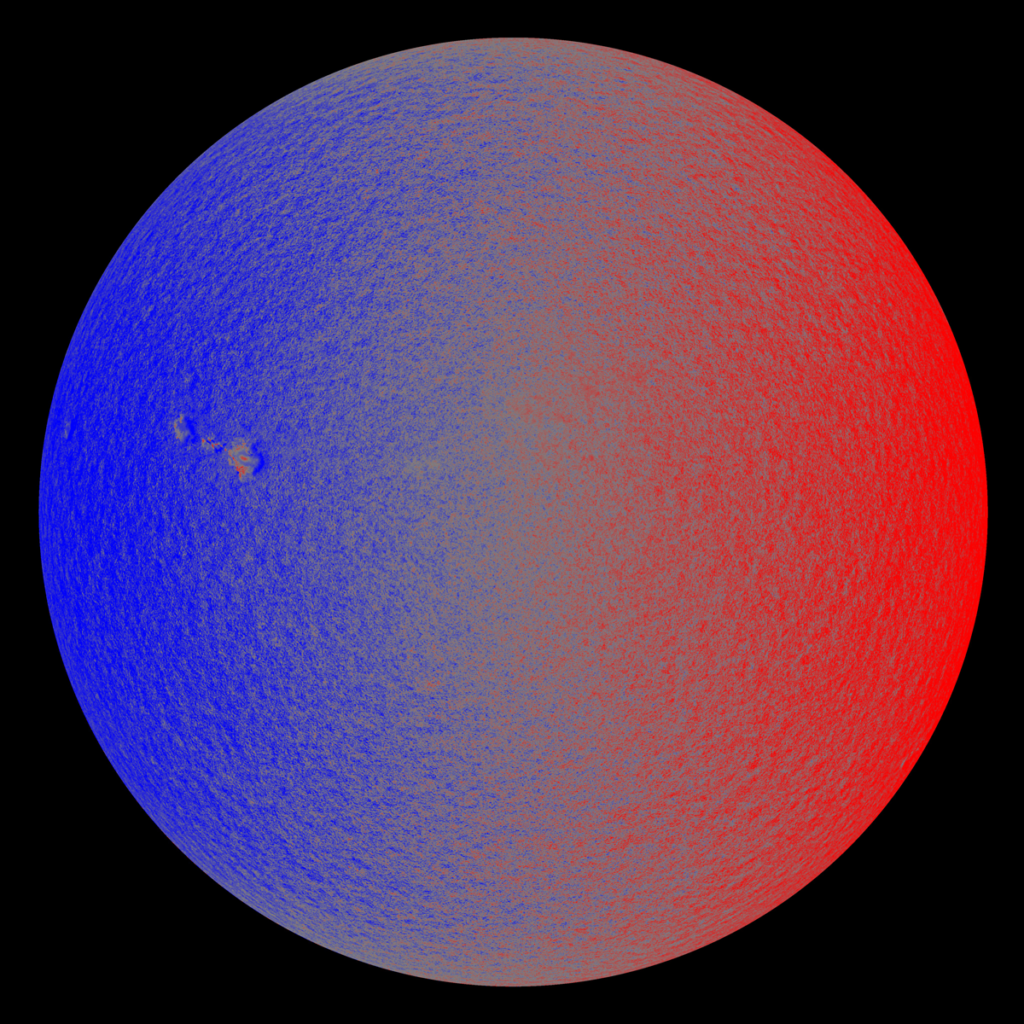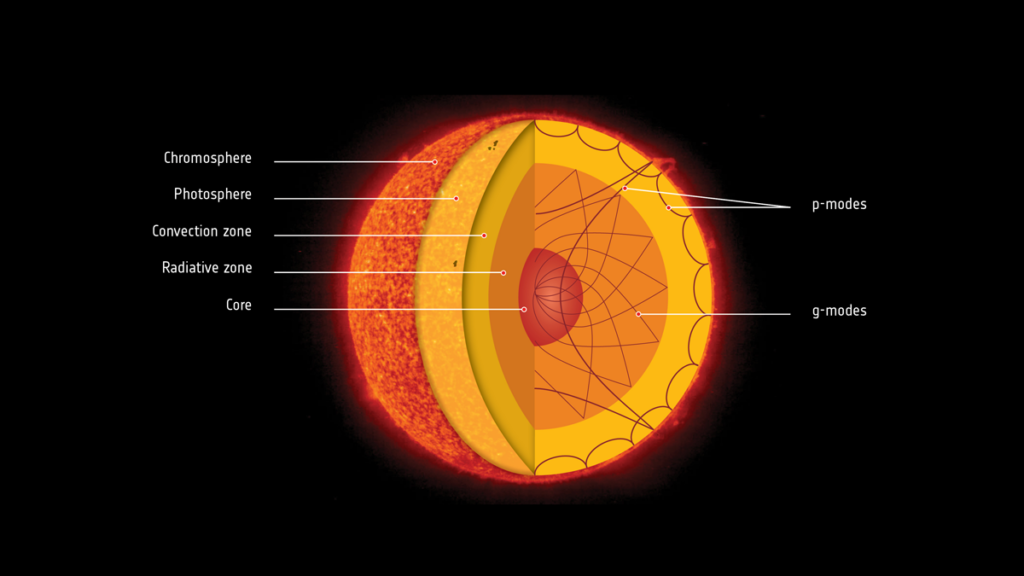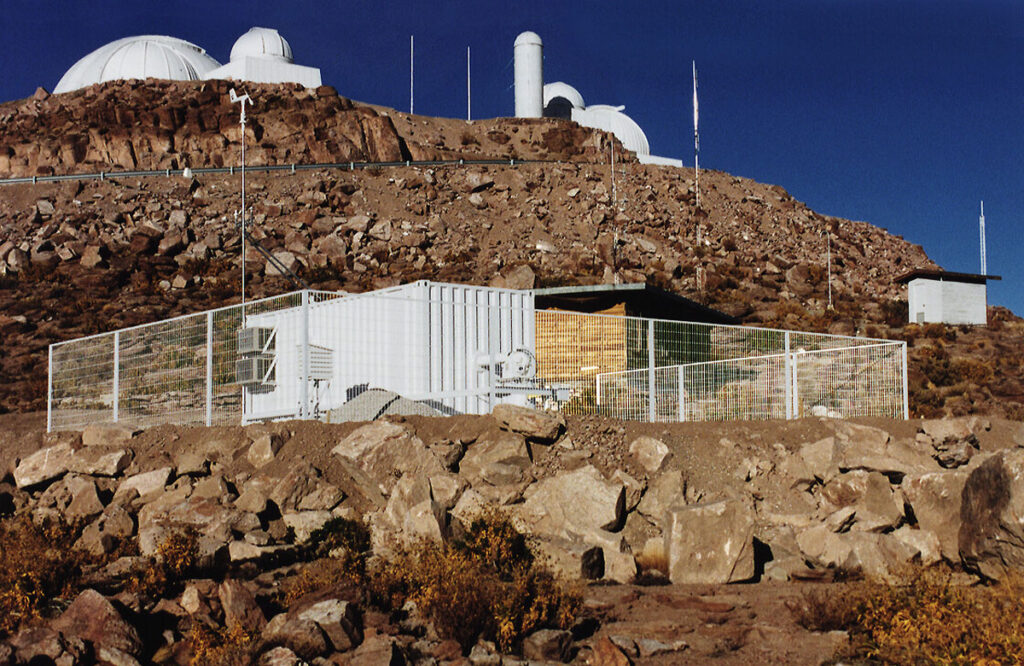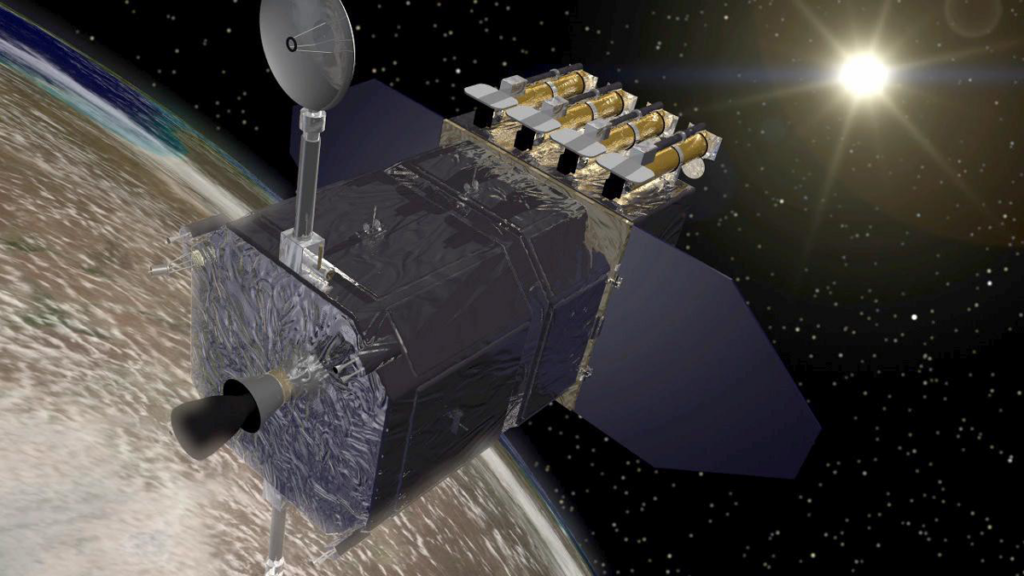It may not roll, but the surface of the Sun shakes and rattles like—pick your favorite analogy—a giant bell, a pipe organ with millions of pipes, or a concert hall filled with the hum of many orchestras tuning at the same time.
Scientists who study the Sun have used those comparisons and others to describe the star’s constant vibrations, caused primarily by sound waves rippling below the surface. Created by the motions of giant bubbles of hot gas, the waves can travel around the entire Sun, moving from the surface to deep inside to the surface again in a cycle that can repeat for anywhere from hours to months.
For solar physicists and others, the waves are powerful tools for studying the Sun, other stars, and even other fields of physics. They have probed the Sun’s interior structure and motions, provided insights into the solar dynamo, and raised questions about the Sun’s chemical composition. They offer a glimpse of the farside of the Sun, improving space weather forecasts. And they helped solve a problem in particle physics that led to a Nobel Prize.

The study of these waves is known as helioseismology, and it uses instruments on the ground and in space to keep a constant eye on the Sun. This effort has provided 3 decades of nonstop observations that have greatly advanced our knowledge of the Sun. “Helioseismology is the only way to see inside the Sun,” said Sushanta Tripathy, an associate scientist at the National Solar Observatory (NSO) in Boulder, Colo.
“All of our observations of the Sun are based on what we can see at the surface,” said Lisa Upton, a research scientist at the Southwest Research Institute, also in Boulder. “We can’t dive in to see inside. But helioseismology is a revolutionary technique. It’s amazing, the things it can do.”
Sound Waves “All Over the Place”
Helioseismology began in the 1960s when Robert Leighton and his colleagues discovered oscillations on the surface of the Sun. “He was looking at solar granulation, and turbulence was a big topic at the time,” said John Leibacher, an emeritus astronomer at NSO and a former director. “He was taking images at a specific wavelength, and he expected, as the images got farther apart in time, they’d look less and less coherent. What he found, much to his great surprise, was that after about 5 minutes, they were back in phase.… He discovered a periodicity on the surface of the Sun, which was completely unexpected.”

A few years later, Leibacher, who studied the phenomenon for his master’s thesis, and others independently devised an explanation: sound waves trapped in a cavity just below the surface, generated by the motions of blobs of hot gas at the top of the Sun’s convection zone.
The Sun consists of three main layers. The core, which accounts for roughly 25% of the Sun’s radius, is where hydrogen nuclei fuse to make helium, converting some of their mass to energy. The core is wrapped by a radiative zone making up more than half of the Sun’s radius, where energy slowly trickles outward. The outer 25% of the solar radius consists of the convection zone, where cells of plasma as big as Texas rise like bubbles in a pot of boiling water. As the cells approach the surface, they cool, lose buoyancy, and sink. That constant churning creates pressure waves (also called sound or acoustic waves) within a few hundred kilometers of the surface.
“As the plasma rises and falls, it creates turbulence,” said Jason Jackiewicz, a professor of astronomy at New Mexico State University in Las Cruces. “That’s a source of acoustic noise. It creates sound waves all over the place, all the time. Some of them interfere constructively, building up a resonance. They’re created at the surface, then go down and back up, down and back up, down and back up. Each oscillation has certain properties, just like the waves in a musical instrument.”
“The region where the waves are created is very noisy,” said Leibacher. “Not to be too anthropomorphic, but it’s like a lot of people screaming and shouting there. Or a better analogy might be a bunch of people sitting on a piano at once. If you listen to it, it’s just white noise. It’s only because the waves last a long time that we can isolate them into individual modes.”
The waves have a roughly 5-minute period. Astronomers have discovered about 10 million individual modes for the waves, with roughly a million of them shaking and rattling the surface at any given time.
Like the seismic waves that travel through Earth as a result of earthquakes, the Sun’s waves have important diagnostic abilities. As they travel into the Sun, they’re refracted toward the surface by changes in temperature, density, and composition. Individual waves are redirected differently depending on the circumstances of their creation and their path through the Sun. A careful analysis thus provides a detailed look at conditions deep in the Sun. Some modes are better tuned to provide details about sunspots and other surface phenomena.
Astronomers “see” the waves by measuring the Doppler shift all across the Sun’s surface. Each wave causes the surface to jiggle up and down a little. The change isn’t dramatic—only a few meters to a few tens of meters per second. To put that in perspective, Usain Bolt runs the 100-meter dash at about 10 meters per second.

Detecting and understanding the waves require long-term monitoring of the Sun. That can’t be accomplished by a single ground-based station, so astronomers have built networks of Sun-watching telescopes across the planet. They’ve also placed instruments in space, where they can stare at the Sun constantly, unobstructed by clouds or the blurring effects of Earth’s atmosphere.
One early helioseismology network was GONG (Global Oscillation Network Group), established by NSO in 1995. Still in operation today, it consists of six small, identical stations around the world, one each in California, Hawaii, the Canary Islands, Australia, Chile, and India. “We joke that the Sun never sets on GONG,” said Leibacher.
Each station, housed in an industrial cargo container, includes an interferometer to measure the Sun’s surface oscillations and an instrument to measure it’s magnetic field, allowing scientists to correlate the surface waves with magnetic activity.
The first space-based helioseismology instrument took to the skies shortly after GONG entered service, aboard SOHO (Solar and Heliospheric Observatory). Although SOHO continues to operate, the instrument was retired in 2011 when it was superseded by the Helioseismic and Magnetic Imager (HMI) aboard the Solar Dynamics Observatory (SDO). HMI provides higher resolution and a higher data rate than its predecessor.

“When ground-based telescopes look at the Sun, they see it through this boiling cauldron of atmosphere,” said SDO project scientist W. Dean Pesnell at NASA’s Goddard Space Flight Center in Maryland. “That introduces a lot of noise. We don’t have that problem.”
Small Particles, Big Science
Early discoveries with helioseismology applied as much to general questions in physics as to the Sun itself, beginning with the “solar neutrino problem.”
Early discoveries with helioseismology applied as much to general questions in physics as to the Sun itself, beginning with the “solar neutrino problem.”
Neutrinos are created in abundance during nuclear fusion reactions in the cores of the Sun and other stars. Because neutrinos are almost massless, they zip through the Sun and Earth without interfering with other particles. That makes them good probes of what’s happening in the Sun’s core, but it also makes them difficult to catch.
Early detectors counted only a third as many neutrinos as expected from models of the solar interior. “The nuclear physicists all said, ‘Oh, our theories are right, and your observations must be wrong—the temperature of the Sun must be a little cooler than you astronomers think,’” said Leibacher. “We said, ‘No, there’s nothing wrong with our observations; there must be something wrong with the physics of neutrinos.’ For once, we were right.”
Helioseismology confirmed that the Sun’s interior temperature profile was as expected, leaving nuclear physicists to ponder other solutions. They eventually realized that the neutrinos produced by the Sun were transforming themselves into one of two other “flavors” as they raced through the solar system. The physicists who discovered the solution received the 2015 Nobel Prize in Physics.
Tachocline and Core
In addition to confirming the Sun’s internal temperatures, early observations also confirmed its interior structure, with a sharp, well-defined boundary at the base of the convection zone that can be pinpointed to within less than 1% of the Sun’s radius.
“There are lovely results on…the existence of the tachocline—a shear layer that marks the transition between the convection zone, which has differential rotation, and the radiative region, which rotates uniformly as far as we can tell,” said Yvonne Elsworth, a professor of helioseismology, physics, and astronomy at the University of Birmingham in the United Kingdom. Elsworth is a former director of the first helioseismology network, BiSON (Birmingham Solar Oscillations Network), which has been watching the Sun since 1976.
Details about the energy-generating core, however, have proven harder to obtain. “The acoustic waves don’t spend very much time there to sense the rotation, and not many of them [go that deep], so they’re hard to observe,” said Jack Harvey, an emeritus astronomer at NSO and one of the creators of GONG. “Our knowledge of the core is very fragmentary.”
Another type of wave, known as a gravity wave, could help test those models. These longer-frequency waves are generated by oscillations in the core itself. They produce little or no signal at the surface, making them difficult to detect.
A 2017 study reported seeing the imprint of gravity waves in 16.5 years of data from SOHO, suggesting that the core rotates roughly once per week, compared with roughly once every 4 weeks at the surface (bit.ly/gravity-sun-core). However not all solar physicists accept these results. “We don’t really know if [gravity waves] have been observed yet,” said Harvey.
Cycling Through the Sunspots
Although helioseismology has not yet answered questions about the core, it’s provided many details about the convection zone, in particular its rotation.
Astronomers have known for centuries that the surface of the Sun rotates differentially. By tracking sunspots as they crossed the solar disk, they could see that the polar regions rotate faster than the equator. Helioseismology confirmed that the differential rotation continues through the convection zone all the way to the shear layer.
“Identifying that shear layer is important because solar activity is caused by magnetic fields, and there was a big question about where the magnetic fielD is generated.”
“Identifying that shear layer is important because solar activity is caused by magnetic fields, and there was a big question about where the magnetic field is generated,” said Alexei Pevtsov, associate director of the NSO Integrated Synoptic Program. “That strong shear layer, at the base of the convection zone, is where the dynamo operates.”
Yet the dynamo is poorly understood, leaving scientists to ponder how it helps drive the Sun’s magnetic cycle.
The cycle lasts roughly 11 years. At its peak, many dark sunspots speckle the Sun’s surface. The peak also produces a greater number of solar flares and eruptions of giant clouds of hot gas known as coronal mass ejections. At the cycle’s low point, the surface is almost bereft of such activity. At the end of a cycle the Sun’s polarity flips, with the north magnetic pole becoming the south magnetic pole and vice versa, making the overall cycle 22 years long.
No two cycles are the same. “The cycle is regular, but it’s not perfectly regular,” said Sarah Gibson, a senior scientist at the National Center for Atmospheric Research’s High Altitude Observatory in Boulder. Cycles vary in both length and intensity. The most recently completed one, which ended in December 2019, was one of the weakest on record. The current cycle was forecast to be equally meager, and it began that way, but it has exceeded projections in recent months.
One key to the solar cycle is a “conveyor-belt” flow revealed by helioseismology. Known as a meridional flow, it resembles the Hadley cells in Earth’s atmosphere. The basic concept says giant cells of plasma move from the equator toward the poles. There, they dive below the surface, then flow back toward the equator, where they return to the surface, completing the cycle.
The flow is “very important to theories of solar activity,” said Harvey. “Our best theories of the solar cycle depend on that kind of flow, so we’d like to know what it’s like. But the measurements are very subtle because the flows move at a few meters per second. You can run that fast.”
The measurements are further complicated by the fact that neither ground-based nor current space-based telescopes can see the poles.
“A polar view is the linchpin in all of this,” said Gibson, who served as project scientist for SOLARIS, a proposed solar polar mission that was rejected by NASA earlier this year. “If we can observe the poles, see the flows, we could rule out some mechanisms.”
Improving Weather Forecasts
Helioseismology is providing rough views of the Sun’s farside, offering warnings of large sunspots days be-fore they rotate into view. “This is one of the big achievements of the whole field of helioseismology.”
Understanding the Sun’s magnetic cycle better is important for a practical application: forecasting space weather. As heavy outbursts of solar radiation and charged particles interact with Earth’s own magnetic field, they can damage orbiting satellites, knock out power grids on Earth’s surface, weaken oil pipelines, and cause other problems. NOAA, the U.S. Air Force, and several international organizations provide space weather forecasts to help operators protect potentially vulnerable assets.
Helioseismology is providing rough views of the Sun’s farside, offering warnings of large sunspots days before they rotate into view. “This is one of the big achievements of the whole field of helioseismology,” said Tripathy.
As waves travel through the Sun, they interact differently with sunspots than with the unblemished surface. And because the waves can travel around the entire star, some of them reveal the presence of farside sunspots as the waves ripple to the nearside. “We can predict that an active region that we’ve never actually seen before will appear on the east limb of the Sun on this date and at this location,” said Leibacher. “It’s an interesting party trick, if you will. It’s also interesting solar physics.”
As the databases of observations grow larger, scientists are testing other interesting bits of solar physics as well. As one example, the observations aren’t necessarily agreeing with profiles of the Sun’s composition obtained through other techniques.
“We compare every star to the Sun—’That star has 10% of the metallicity of the Sun, or that star has twice the metallicity.’ That’s great, but it assumes we know the metallicity of the Sun. I don’t know that anyone’s willing to say we know that for sure anymore.”
The Sun consists almost entirely of hydrogen and helium, with a smattering of heavier elements—about 2% of its total mass—that were forged inside other stars. The heavier elements, known as metals, were expelled into space when the stars died and were then incorporated into the Sun as it formed from a cloud of interstellar gas and dust. Slight variations in the proportions of these elements cause differences in a star’s internal temperatures and other characteristics, so fully understanding what’s going on inside a star today—and how the star will evolve—requires precise knowledge of its composition.
It seems like there are fewer metals in the Sun than researchers thought, said Jackiewicz. “That has major implications for stellar astrophysics in general. We compare every star to the Sun—‘That star has 10% of the metallicity of the Sun, or that star has twice the metallicity.’ That’s great, but it assumes we know the metallicity of the Sun. I don’t know that anyone’s willing to say we know that for sure anymore.”
From One Star to Many
Although astronomers use helioseismology in part to learn about how other stars operate, they use a similar technique—asteroseismology—to study other stars in part to learn about the Sun.
Asteroseismology observations have come from the databases of Kepler, TESS (Transiting Exoplanet Survey Satellite), and other satellites designed to hunt for exoplanets. The craft keep a steady gaze on large numbers of star systems for weeks or longer, so their observations can be used to glean information about the stars as well as their planets.
Because the stars are so far away, they appear as just pinpoints of light, so astronomers can’t detect the shaking and rattling with the same level of detail as on the Sun. Instead of millions of different modes, they see perhaps a few dozen, observed as minor changes in brightness rather than changes in surface motion, which are integrated across the star’s entire disk. Still, that provides enough information to characterize a star’s interior temperature and structure.
“We’ve measured the pulsations of about 30,000 stars,” said Jackiewicz. The vast majority are red giants—old, bloated stars that have converted the hydrogen in their cores to helium and now are beginning to fuse the helium to produce heavier elements. “That’s the boon of the last 10 years of asteroseismology, which is great, because the Sun will become a red giant in a few billion years.”
A red giant’s core is smaller, denser, and hotter than the Sun’s, so it produces stronger gravity waves, which are more easily detected at the star’s surface. “So we know more about the rotation of the cores of red giants than the Sun,” Jackiewicz said.
With asteroseismology, “we can look at 10,000 different realizations of the Sun,” said Leibacher. “We can observe the Sun only today, not in a million or a billion or 5 billion years. But we…can do asteroseismology of what the Sun will become, which is pretty amazing.”
Asteroseismology is also helping astronomers study exoplanets. “The properties of the stars are tied to the properties of the planets,” said Jackiewicz. “With seismology, we have access to parameters and things that traditional observations don’t. So we can tell if it’s a Jupiter-type planet or an Earth-type planet. It’s a really active area of research.”
Helioseismology remains an active area as well, although its tools are aging. SDO, for example, has been operating for more than 12 years. Although it’s in good shape and could go for several more years if it receives funding, according to Pesnell, its instruments can’t be upgraded, and the spacecraft can’t be serviced if something goes wrong.
And GONG “is getting a little long in the tooth,” according to both Harvey and Leibacher. “It was designed for 3 years, not 30,” said Harvey.
GONG scientists have proposed a next-generation version of the network that would incorporate improved instruments, better enclosures than the current cargo containers, and perhaps sites at higher altitudes to enable observations of the Sun’s hot outer atmosphere, the corona. Last year, however, the National Science Foundation rejected a proposal for the new network.
“We’ve refurbished GONG’s cameras and computers, so we can probably extend it for another 5, 7, maybe 10 years, but not more than that,” said Pevtsov. “It won’t last forever.”
“I think a next-generation GONG is more or less inevitable; it’s only a matter of how and when,” said Leibacher. “But we can’t just skip a [solar] cycle. You can’t rewind and see what happened 10 years ago. You have to be observing day by day to try to make sense of the Sun’s dynamo”—and understand how the surface keeps shaking and rattling with a million vibrations.
Author Information
Damond Benningfield ([email protected]), Science Writer


